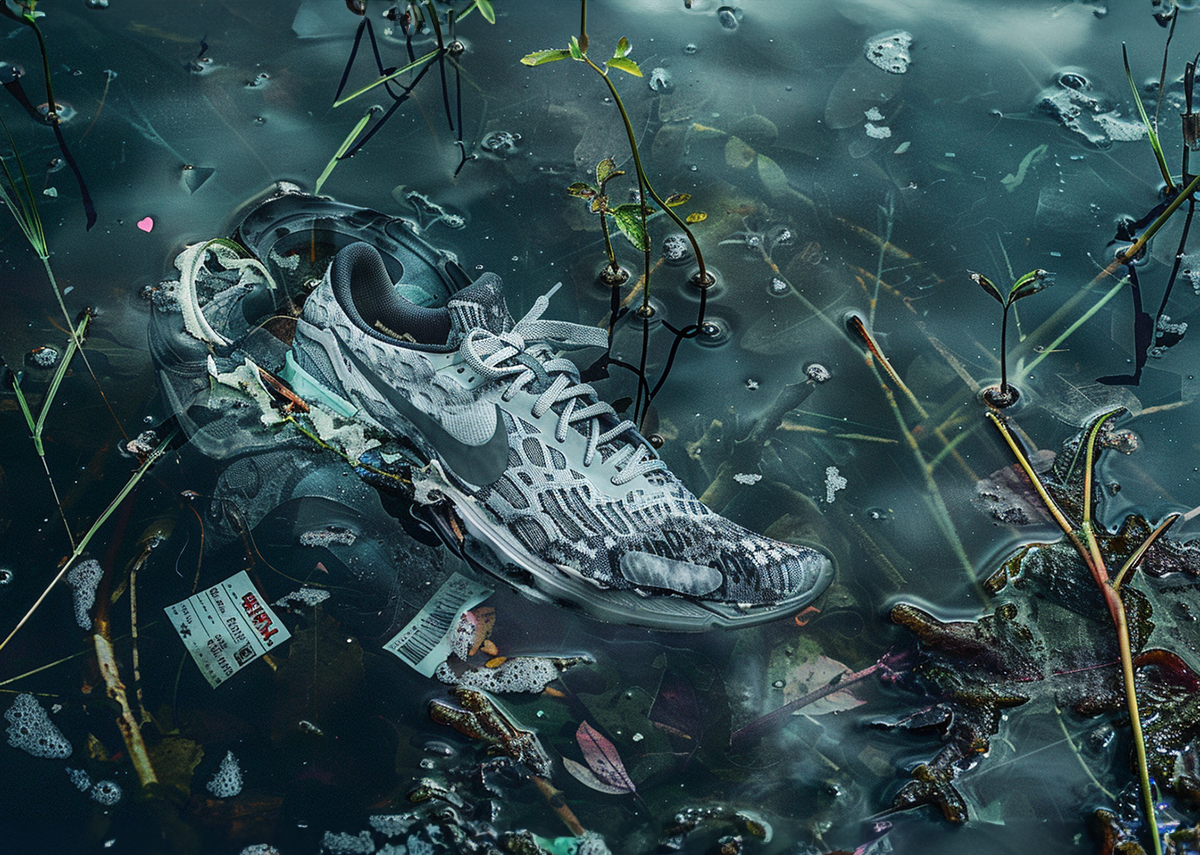Sales & Marketing Learnings: About the addiction to performance marketing – when “Nike” lost its lead with inefficient online advertising
Language selection 📢
Published on: August 8, 2024 / update from: August 8, 2024 - Author: Konrad Wolfenstein

Sales & Marketing Learnings: About the addiction to performance marketing – when “Nike” lost its lead with inefficient online advertising – Image: Xpert.Digital
📌 Note: Despite its scope, this contribution is still too short. Therefore, further consequences that go deeper into the topic will. 🔍📈
🎽🚫 Nike in the marketing dilemma: the steep descent of a sporting code due to false strategies
🏃♂️✨ The case of Nike impressively illustrates how a former icon of sport through a missed marketing strategy can maneuver itself. For decades, Nike built his image through gigantic sponsorship contracts and unforgettable advertising campaigns. These measures not only shaped the perception of the brand, but also created a strong emotional bond between the brand and its consumers.
🚀🌐 With the switch in 2020 to digital direct sales and performance marketing, Nike tried to adapt to the changed market conditions, especially during the lockdowns. At first, this step seemed effective because online sales rose and the inventory got in motion. But this strategy had a long -term disadvantages.
💹📉 Performance marketing is heavily based on measurable key figures such as clicks and conversion rates. This often means that short -term sales impulses and discounts put in the foreground. Also at Nike: Discount campaigns were necessary to boost sales, but these led to a dilution of the brand and significantly damaged the profit margins. Instead of promoting the desirability and exclusivity of the brand, Nike became another provider in the saturated market for sports shoes and clothing.
📊📈 The result was a drastic increase in inventory, as the public reports made. From May 31, 2021, the inventory rose from $ 6.5 billion to $ 10 billion on November 30, 2022. This development illustrates that Nike was no longer able to react precisely to the market needs. The wrong products were produced in the wrong quantities and delivered at the wrong times.
❗ Nike's error shows that a purely focus on measurable results in marketing - which appears particularly easy for digital advertising - is not always the best strategy. This approach can be counterproductive, especially for lifestyle brands that live on their image and "coolness". Emotions and brand binding cannot always be put into numbers. They are based on experiences, on a deep connection between the brand and its supporters, which is fed through exclusive events, innovative products and strong visual messages.
💡📊 The lesson from Nike's experience is clear: performance marketing is justified and can be very effective in certain contexts. But for brands that rely on their cultural relevance and lifestyle appeal, it is also important to maintain a balanced and multi-layered marketing mix. It is important to find the balance between measurable performance goals and difficult to measure brands in order to secure sustainable success and not only achieve short-term growth.
📣 Similar topics
- 📣 A descent through the wrong strategy: Nike and performance marketing
- 💡 The pitfalls of performance marketing at Nike
- ⏳ From icon to irrelevance: How Nike affects his image
- 🔍 Performance marketing: a double-edged sword for Nike
- 📉 Stored stock in sight: Nike's quantity problem and the consequences
- 💔 From the lifestyle to mass-produced: Nikes Marketing Fiasko
- 📊 Key figures vs. Brand binding: The problem at Nike
- 🛍️ discount battles and their dark sides for Nike
- 🤔 Why Nike lost the balance in marketing
- 🎯 Lessons from Nike's marketing errors
#️⃣ Hashtags: #nike #marketing #Performancemarketing #markenimage #lagerkeste
🏷️📦 Performance marketing vs. Brand binding: Nike's balancing act in the digital age
🌟 Nike's strategies in change: short -term profits versus long -term brand maintenance
Nike, one of the world's leading sports clothing and shoe brands, is currently facing a significant dilemma. The balance between short -term, measurable success and sustainable brand structure is a crucial tension sheet in everyday business life. The focus on short-term profits through performance marketing has brought temporary advantages, but the long-term effects on the brand image and customer loyalty cannot be overlooked.
💼 Effect of performance marketing on the brand
Performance marketing, known for its immediately measurable results, Nike gave a clear competitive advantage at short notice. It is a marketing method in which the efficiency of the advertising measures is directly evaluated and optimized in order to achieve high profitability as quickly as possible. However, this strategy also has its dark sides.
While performance marketing can be increased at short notice and new customers can be obtained, brand perception often suffers. At Nike, this had a negative impact on the image and undermined customer loyalty. Customer loyalty is not only based on the quality of the products, but also on the emotional connection to the brand, which is influenced by numerous factors such as the brand message, values and the overall experience. Too strong focus on short -term marketing measures can weaken this emotional bond.
🛒 challenges in e-commerce
The increasing pressure and the significant shift towards e-commerce brought additional challenges for Nike. The quick adaptation to the changed consumer behavior and coping with supply chain problems required strategic reorientations. A meaningful point here is the "unexpected" consumer behavior. In e-commerce, the price of the main competition lever is not in harmony with Nike's traditional brand strategy, which high margins supported by the promise of value and not by price struggles.
Nike was traditionally able to use its branded power to sell products at premium prices. But the extensive range of price comparisons and discounts in online trading endangered this advantage. Consumers are increasingly price sensitive and use the Internet to find the best offers. This led to an intensive price competition in which discounts and special offers became the norm, which in the long run damaged Nike's gross margins. This development required a radical rethink in relation to price strategies and promises.
📦 The problem of inventory management
Another problem that Nike met in the context of e-commerce was the inventory management. The high demand for certain products led to bottlenecks in the supply chain, while other products led to considerable inventory due to overproduction. The pressure to dismantle these inventory inevitably led to price reductions and other discounts, which in turn stressed the margins and impaired the brand image. This dilemma shows how critically an efficient and flexible supply chain strategy is for success in e-commerce.
📈 Investments in performance marketing versus traditional advertising
There are increasingly evidence in academic literature that investments in performance marketing and programmatic advertising can be inefficient. These inefficiencies result from several factors, including advertising fraud, increasing costs for intermediaries and a decreasing reaction from consumers to these marketing measures. Despite these findings, Nike invested considerable sums in performance marketing because the results were easily measurable. However, there is a clear dichotomy between easier measurability and actual effectiveness.
Traditional marketing measures such as branding and storytelling may be more measurable, but they contribute significantly to long -term brand strengthening. When weighting the marketing editions, it is crucial to find the balance between short -term and long -term benefit. The challenge for management is to recognize the value of brand structure and make appropriate investments, although these are more difficult to grasp quantitatively.
💡 Necessity of innovations
Another critical point for Nike is the lack of product innovations. Innovations are the heart that maintains the interest of consumers and keeps the brand relevant. Recently, Nike seemed to be falling behind some competitors in this regard. While the focus was on performance marketing and e-commerce, continuous product development was neglected, which led to an innovation backlog.
However, innovation not only means new products, but also new marketing strategies and technologies. Nike must steadily look for new ways to address consumers and to exceed their expectations. This means investing in research and development and being ready to question and adapt existing success models.
🏁 nikes dilemma
Nikes Dilemma is an impressive example of the challenges that companies face in a rapidly changing market environment. The balancing act between short-term profits through performance marketing and long-term brand structure is complex and requires strategic foresight. The switch to e-commerce brings new challenges, especially with regard to price competition and inventory management. At the same time, the focus on innovations must not be neglected in order to keep the brand relevant and attractive.
Nike has to learn again to draw from the previous experiences and to pursue a balanced strategy that takes into account both short -term and long -term goals. This is the only way to assert its position as a leading brand and at the same time meet the increasing requirements and expectations of modern consumers.
📣 Similar topics
- 🏃♂️ Nikes Dilemma: Short -term profits vs. Long -term brand structure
- 📈 Performance marketing: faster sales, but long-term damage?
- 🛒 Challenges in e-commerce: price competition and consumer behavior
- 📦 inventory management: a balancing act between inventory and margins
- 📉 Inefficiencies in performance marketing vs. Traditional advertising
- 🆕 Innovations: The key to long -term relevance for Nike
- 🌱 Sustainability and social responsibility: a must for the brand
- 💡 New marketing strategies: ways out of performance marketing dilemma
- 🔄 Adaptation to changed consumer needs in online trading
- 🎯 Brand binding in the digital age: more than just sales figures
#️⃣ hashtags: #nike #Perperformancemarketing #ecommerce #sustainability #marken structure
🌟🏅 How Nike achieved a feeling of belonging through 'just do it'
🏅 Brand structure and emotional binding
Nike's historical success was based on a strong emotional bond with his customers. This binding was created by iconic advertising campaigns and sponsorship of outstanding athletes. Through their emotional effect and their high recognition value, such initiatives have created a strong brand loyalty and desire. Examples of this are campaigns such as "Just Do IT", which not only looked inspiring, but also conveyed a feeling of belonging to the brand.
⚠️ The risk of the discount loop
A major problem with the digital performance marketing strategy is the dependence on discounts. Although they promote sales at short notice, they can damage the brand image in the long term and lead to the expectation of constant discounts. Customers get used to buying products only if they receive significant discounts, which reduces the price perception and the perceived value of the brand.
🔄 The way forward: combination of strategies
Nike's challenge is now to find a balance between digital dynamics and traditional brand structure. The digital channels offer a wonderful platform to implement targeted marketing measures and interact directly with customers. But this should not be done at the expense of the long -term brand image.
1. 🔗 Hybrid models for marketing and sales
A future-oriented approach could be the combination of traditional strengths in sponsorship and event marketing with the advantages of digital advertising options. Nike could continue to use large sporting events and athletes as a brand ambassador, while it drives digital campaigns that specifically highlight these events and people.
2. 🌐 Experience marketing in digital space
Concentrated efforts in the field of experience marketing also in digital space, such as virtual events, exclusive online experiences and community building measures, could help revive the "coolness" and exclusivity of the brand. Such measures bind customers emotionally and help to build a strong brand image, even without physical contact.
3. 🌱 Sustainable products and social responsibility
Sustainability and social responsibility are important factors for the success of a brand today. Nike can use its innovative strength and brand history to become a leader in sustainable products and initiatives for social justice. These measures not only help to strengthen the brand image, but also address a growing customer group that attaches importance to ethical consumption.
4. 🎯 personalized and targeted advertising
The effective use of data and artificial intelligence (AI) To personalize customer approach, Nike can help to bring relevant content and offers to the right target groups at the right time. This increases the efficiency of the advertising measures and at the same time strengthens customer loyalty.
🏁 Nike marketing strategy and the resulting problems
The dramatic change in Nike's marketing strategy and the resulting problems offer a valuable lesson about how important a holistic view of marketing is. Performance marketing and digital advertising undoubtedly have their place in a modern marketing strategy, but they must not displace the uniqueness and emotional bond that characterize a brand like Nike. Only through the right combination of traditional and digital measures can Nike be successful in the long term and regain his status as a cultural and sporting icon.
📣 Similar topics
- 🏆 Nike's secret of success: emotional customer loyalty
- 🔥 The power of the “Just Do IT” campaign
- 🔍 Risks and potential of digital discount strategies
- 🎯 The balance between digital and traditional brand structure
- 🤝 Hybrid models: Tradition meets digital
- 🛠️ Experience marketing: Creating exclusive online experiences
- 🌱 Sustainability as a key factor for brand success
- 🚀 Personalized advertising through data and AI
- 💡 Long -term success through combined marketing strategy
- 📣 Iconian athletes as a brand ambassador
#️⃣ hashtags: #marken structure #emotional binding #experience marketing #sustainability #personalized advertising
Our recommendation: 🌍 Limitless reach 🔗 Networked 🌐 Multilingual 💪 Strong sales: 💡 Authentic with strategy 🚀 Innovation meets 🧠 Intuition
At a time when a company's digital presence determines its success, the challenge is how to make this presence authentic, individual and far-reaching. Xpert.Digital offers an innovative solution that positions itself as an intersection between an industry hub, a blog and a brand ambassador. It combines the advantages of communication and sales channels in a single platform and enables publication in 18 different languages. The cooperation with partner portals and the possibility of publishing articles on Google News and a press distribution list with around 8,000 journalists and readers maximize the reach and visibility of the content. This represents an essential factor in external sales & marketing (SMarketing).
More about it here:
📌 Other suitable topics
We are there for you - advice - planning - implementation - project management
☑️ SME support in strategy, consulting, planning and implementation
☑️ Creation or realignment of the digital strategy and digitalization
☑️ Expansion and optimization of international sales processes
☑️ Global & Digital B2B trading platforms
☑️ Pioneer Business Development
I would be happy to serve as your personal advisor.
You can contact me by filling out the contact form below or simply call me on +49 89 89 674 804 (Munich) .
I'm looking forward to our joint project.
Xpert.Digital - Konrad Wolfenstein
Xpert.Digital is a hub for industry with a focus on digitalization, mechanical engineering, logistics/intralogistics and photovoltaics.
With our 360° business development solution, we support well-known companies from new business to after sales.
Market intelligence, smarketing, marketing automation, content development, PR, mail campaigns, personalized social media and lead nurturing are part of our digital tools.
You can find out more at: www.xpert.digital - www.xpert.solar - www.xpert.plus

































